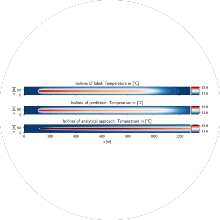New SFB 1313 publication, published in "Geoenergy Science and Engineering". The work has been developed by researchers involved in Project D-X1.
Authors
- Julia Pelzer (University of Stuttgart, research project D-X1)
- Miriam Schulte (University of Stuttgart, PA-D)
Abstract
This paper presents an innovative approach to model the impact of geothermal heat pumps on groundwater temperature and the interaction of multiple heat plumes within the aquifer. The significance of this research lies in its applicability to real-time urban planning through a web application, where traditional simulation methods prove too time-consuming. Our methodology involves a two-stage neural network approach, leveraging convolutional neural networks (CNNs), trained on a simulated dataset constructed with realistic subsurface flow parameters extracted from borehole measurements in the Munich region.
The research process is systematically structured into stages: the first stage rapidly predicts the general shape of a single heat pump’s plume in the absence of other influences. Building upon this, the second stage refines predictions by incorporating the interactions with neighboring heat plumes. Both stages employ CNNs, allowing for efficient training and evaluation. Experiments are conducted on dataset sizes of 100 and 1000 data points and on input parameters, focusing on a reduced dataset with data points of a spatial size of 256x16 pixels. The dataset is split into 70% training, 20% validation and 10% test data.
Our results showcase the effectiveness of our approach, achieving a Root Mean Square Error (RMSE) of approximately 0.1 °C in both stages. This level of accuracy demonstrates the viability of our two-stage model in capturing the complex dynamics of GHWP interactions in shallow aquifers. The proposed methodology not only outperforms known analytical approximations but also significantly reduces computational costs of simulations, making it a promising tool for practical applications in city planning and beyond.


